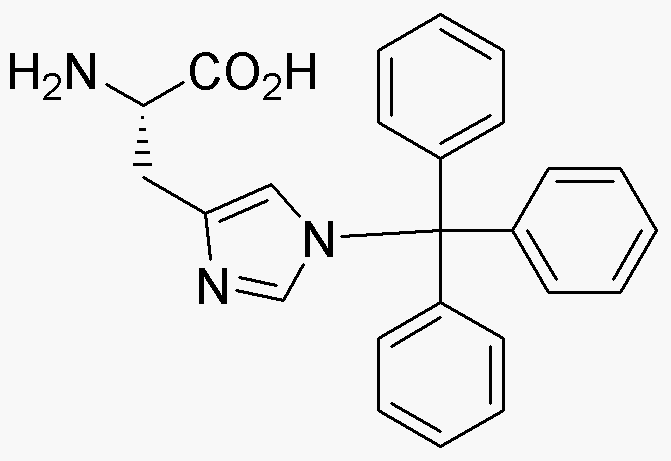Nim-Trityl-histidine is widely utilized in research focused on:
- Peptide Synthesis: This compound serves as a valuable building block in the synthesis of peptides, allowing researchers to create complex structures with specific biological functions.
- Drug Development: Its unique properties make it a candidate for developing new pharmaceuticals, particularly in targeting specific receptors or enzymes in the body.
- Bioconjugation: Nim-Trityl-histidine can be used in bioconjugation processes, facilitating the attachment of drugs or imaging agents to biomolecules for enhanced therapeutic efficacy or diagnostic capabilities.
- Protein Engineering: This chemical aids in the modification of proteins, helping scientists design proteins with improved stability or activity for various applications in biotechnology.
- Research in Cancer Therapeutics: Its potential role in targeting cancer cells makes it a focus in the development of novel cancer treatments, offering hope for more effective therapies.
General Information
Properties
Safety and Regulations
Applications
Nim-Trityl-histidine is widely utilized in research focused on:
- Peptide Synthesis: This compound serves as a valuable building block in the synthesis of peptides, allowing researchers to create complex structures with specific biological functions.
- Drug Development: Its unique properties make it a candidate for developing new pharmaceuticals, particularly in targeting specific receptors or enzymes in the body.
- Bioconjugation: Nim-Trityl-histidine can be used in bioconjugation processes, facilitating the attachment of drugs or imaging agents to biomolecules for enhanced therapeutic efficacy or diagnostic capabilities.
- Protein Engineering: This chemical aids in the modification of proteins, helping scientists design proteins with improved stability or activity for various applications in biotechnology.
- Research in Cancer Therapeutics: Its potential role in targeting cancer cells makes it a focus in the development of novel cancer treatments, offering hope for more effective therapies.
Documents
Safety Data Sheets (SDS)
The SDS provides comprehensive safety information on handling, storage, and disposal of the product.
Product Specification (PS)
The PS provides a comprehensive breakdown of the product’s properties, including chemical composition, physical state, purity, and storage requirements. It also details acceptable quality ranges and the product's intended applications.
Certificates of Analysis (COA)
Search for Certificates of Analysis (COA) by entering the products Lot Number. Lot and Batch Numbers can be found on a product’s label following the words ‘Lot’ or ‘Batch’.
*Catalog Number
*Lot Number
Certificates Of Origin (COO)
This COO confirms the country where the product was manufactured, and also details the materials and components used in it and whether it is derived from natural, synthetic, or other specific sources. This certificate may be required for customs, trade, and regulatory compliance.
*Catalog Number
*Lot Number
Safety Data Sheets (SDS)
The SDS provides comprehensive safety information on handling, storage, and disposal of the product.
DownloadProduct Specification (PS)
The PS provides a comprehensive breakdown of the product’s properties, including chemical composition, physical state, purity, and storage requirements. It also details acceptable quality ranges and the product's intended applications.
DownloadCertificates of Analysis (COA)
Search for Certificates of Analysis (COA) by entering the products Lot Number. Lot and Batch Numbers can be found on a product’s label following the words ‘Lot’ or ‘Batch’.
*Catalog Number
*Lot Number
Certificates Of Origin (COO)
This COO confirms the country where the product was manufactured, and also details the materials and components used in it and whether it is derived from natural, synthetic, or other specific sources. This certificate may be required for customs, trade, and regulatory compliance.


